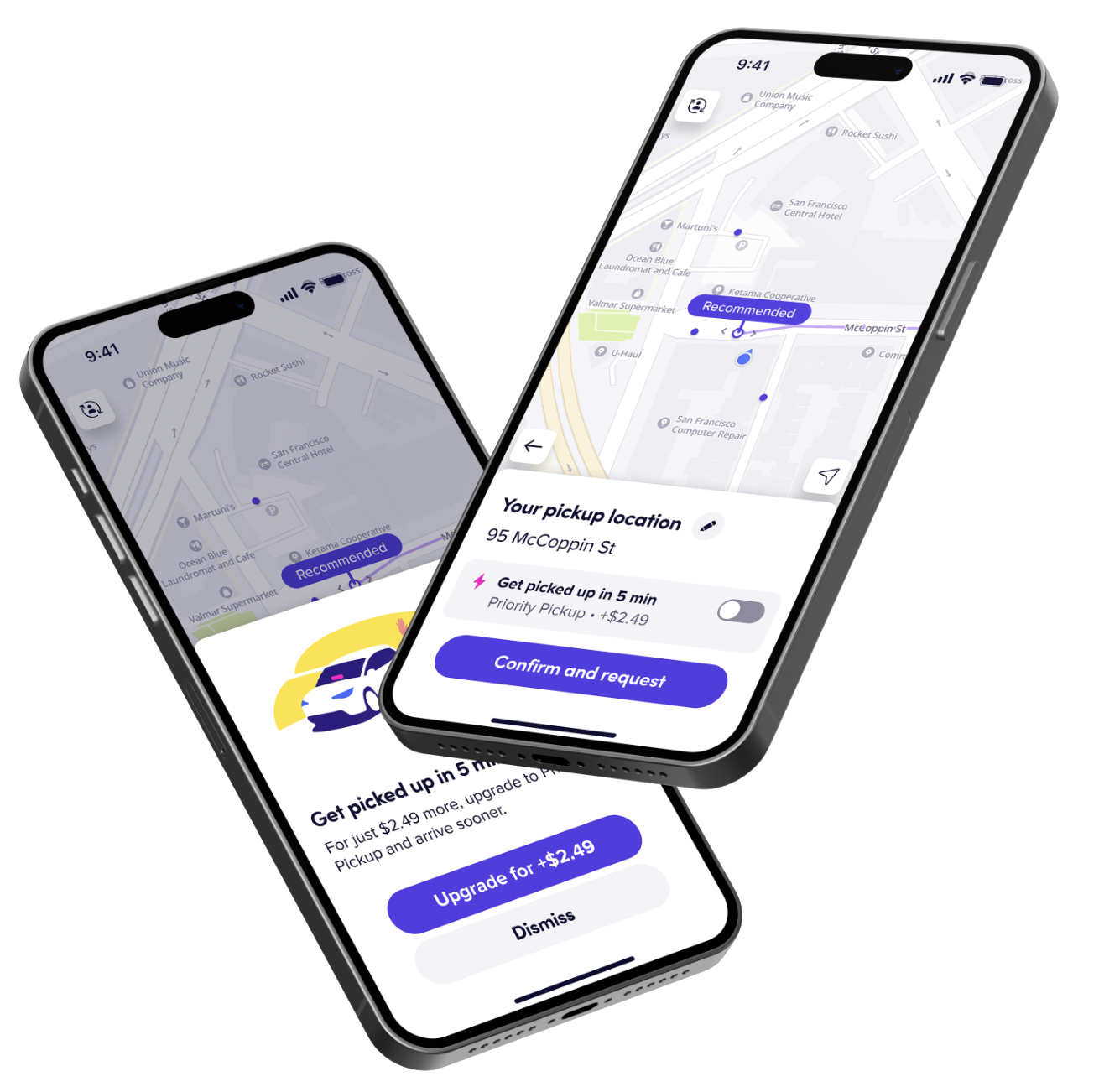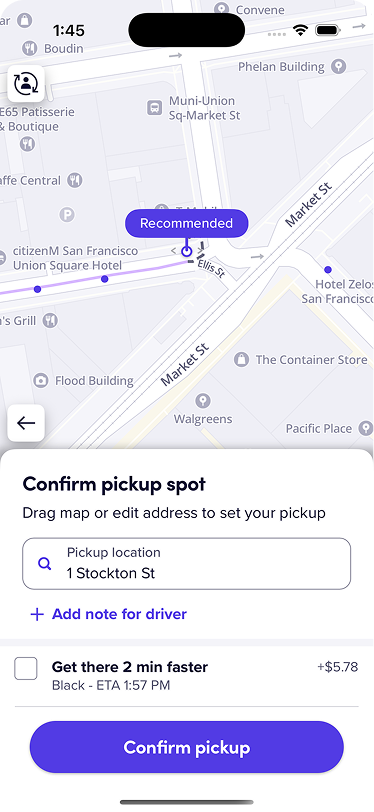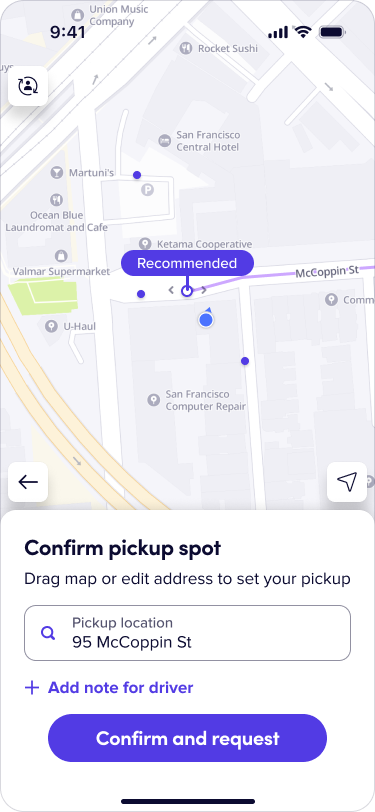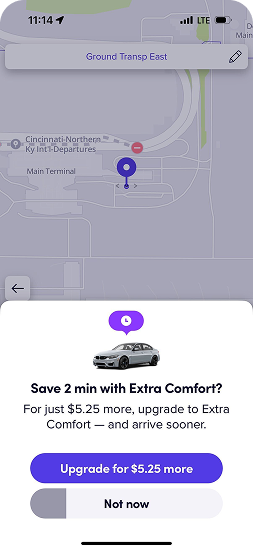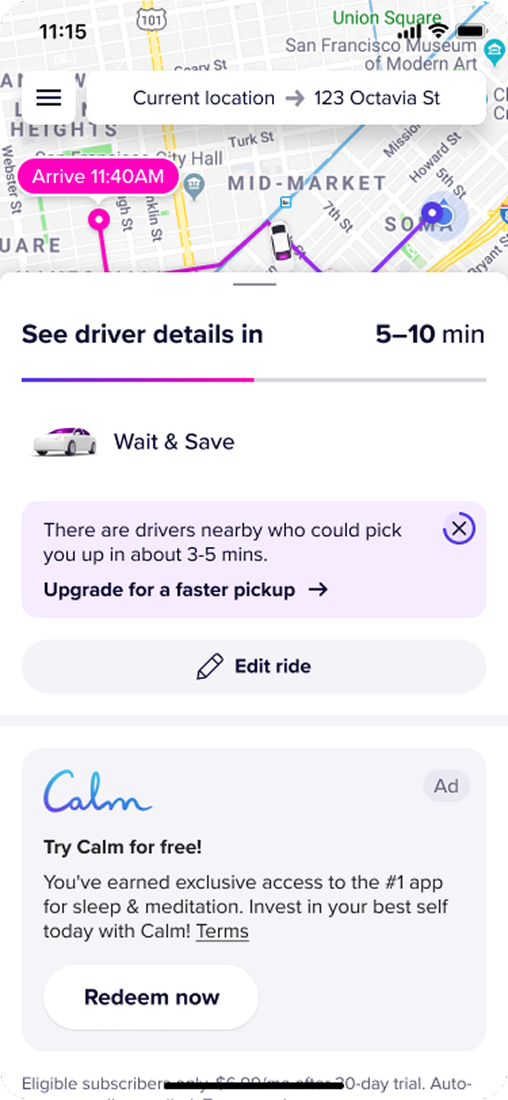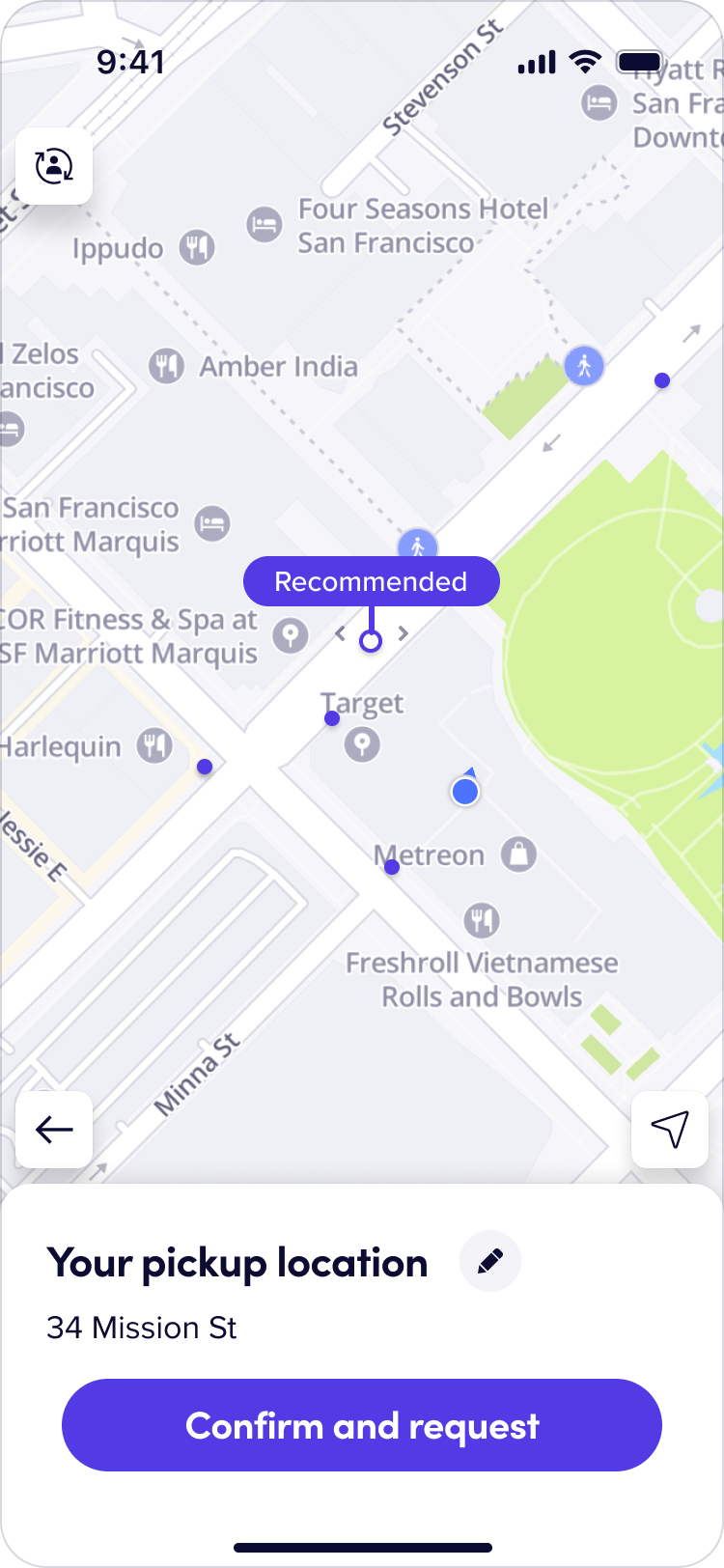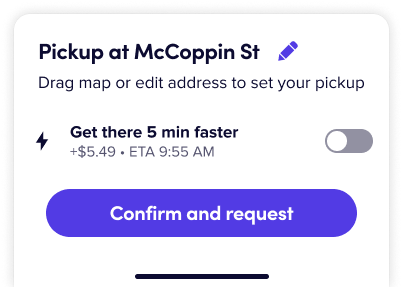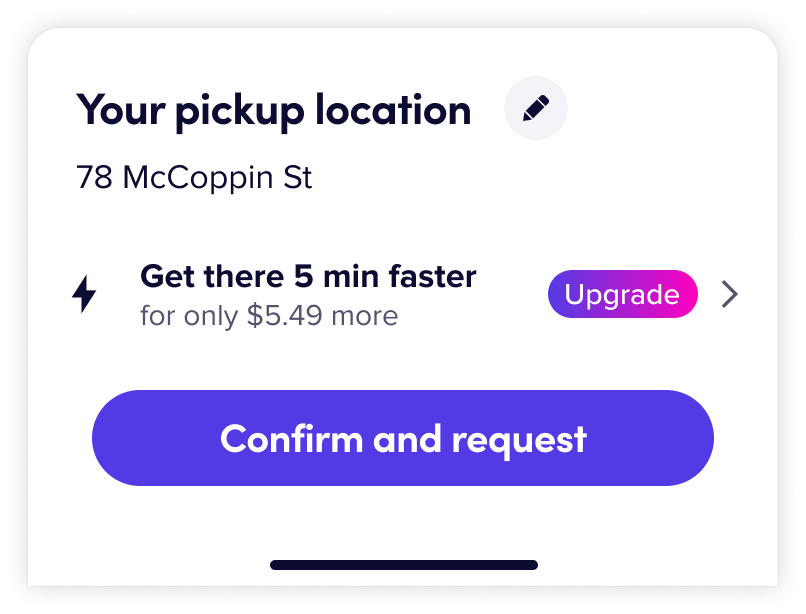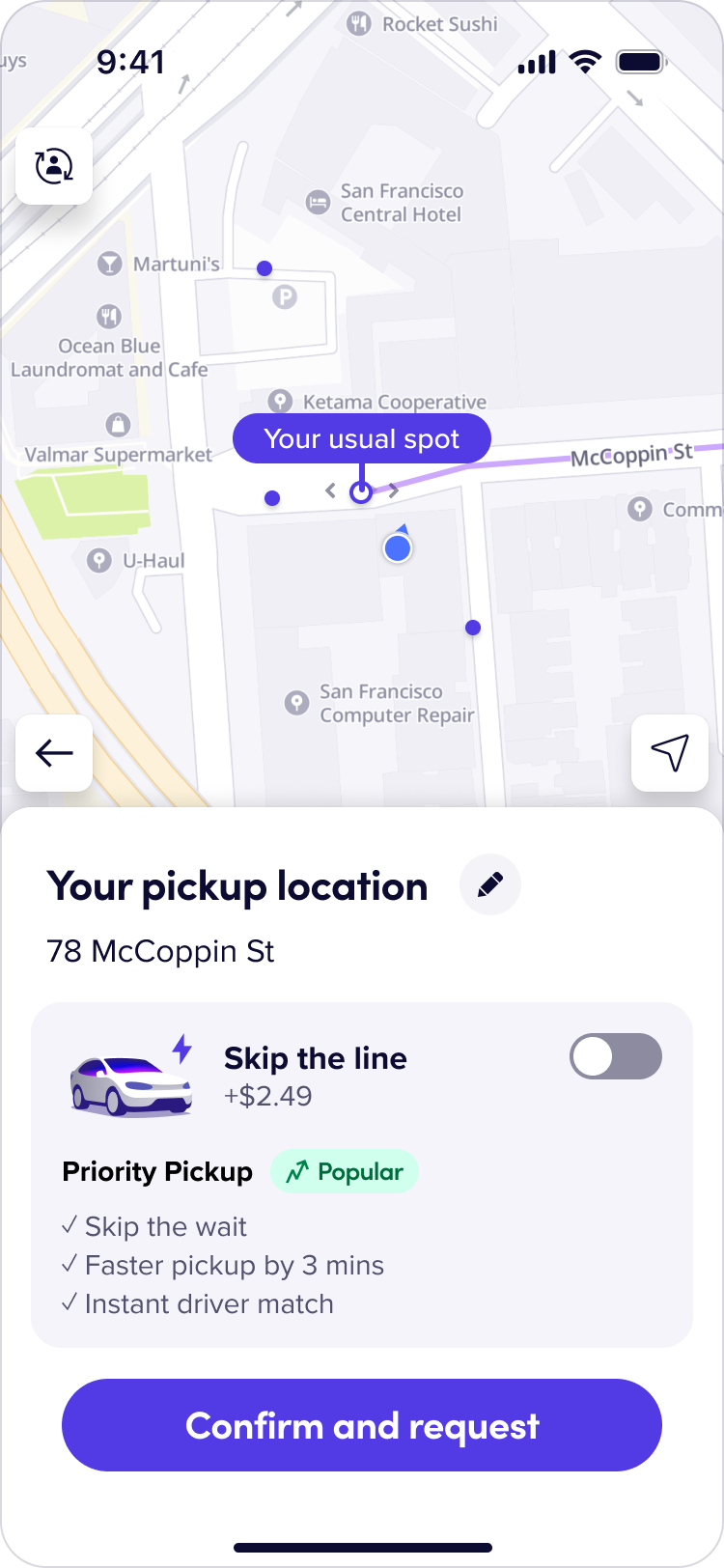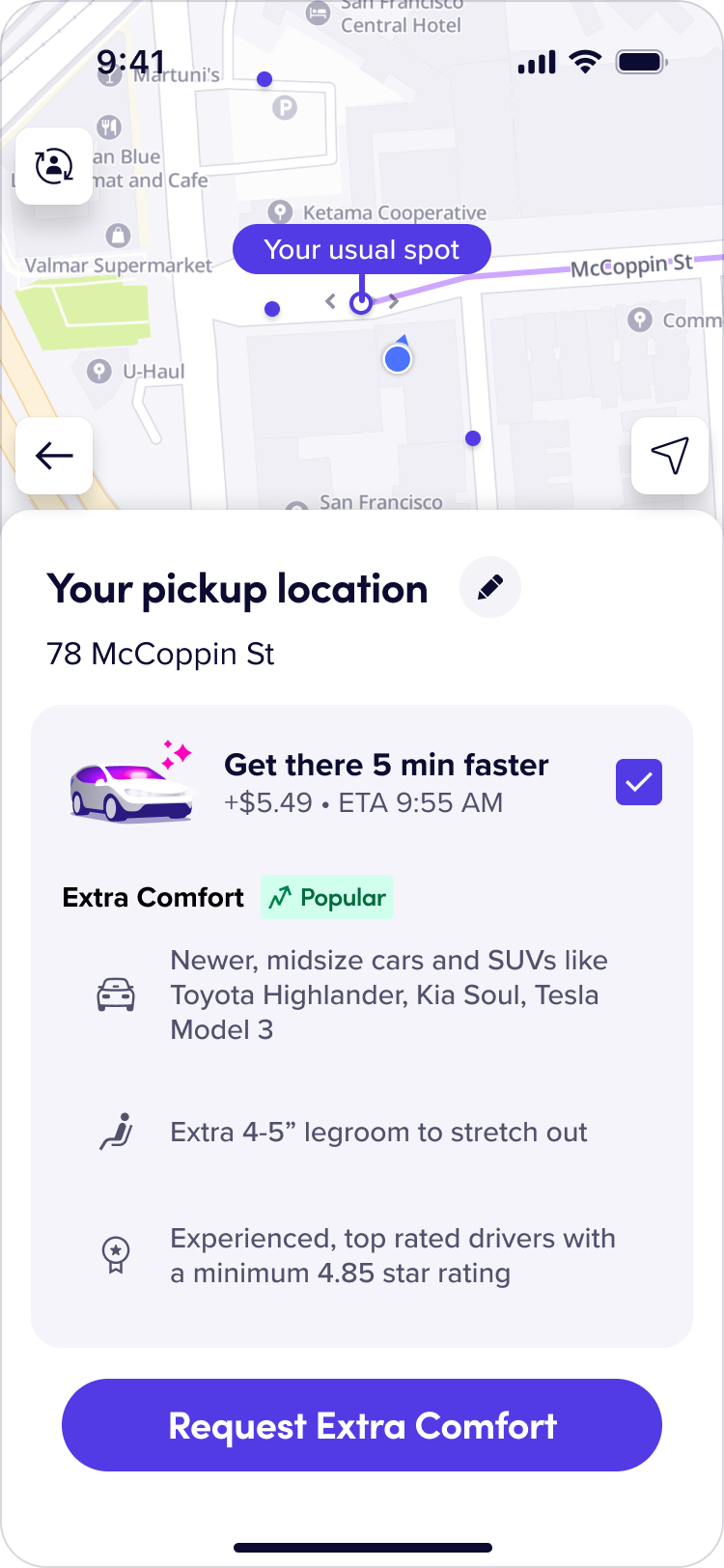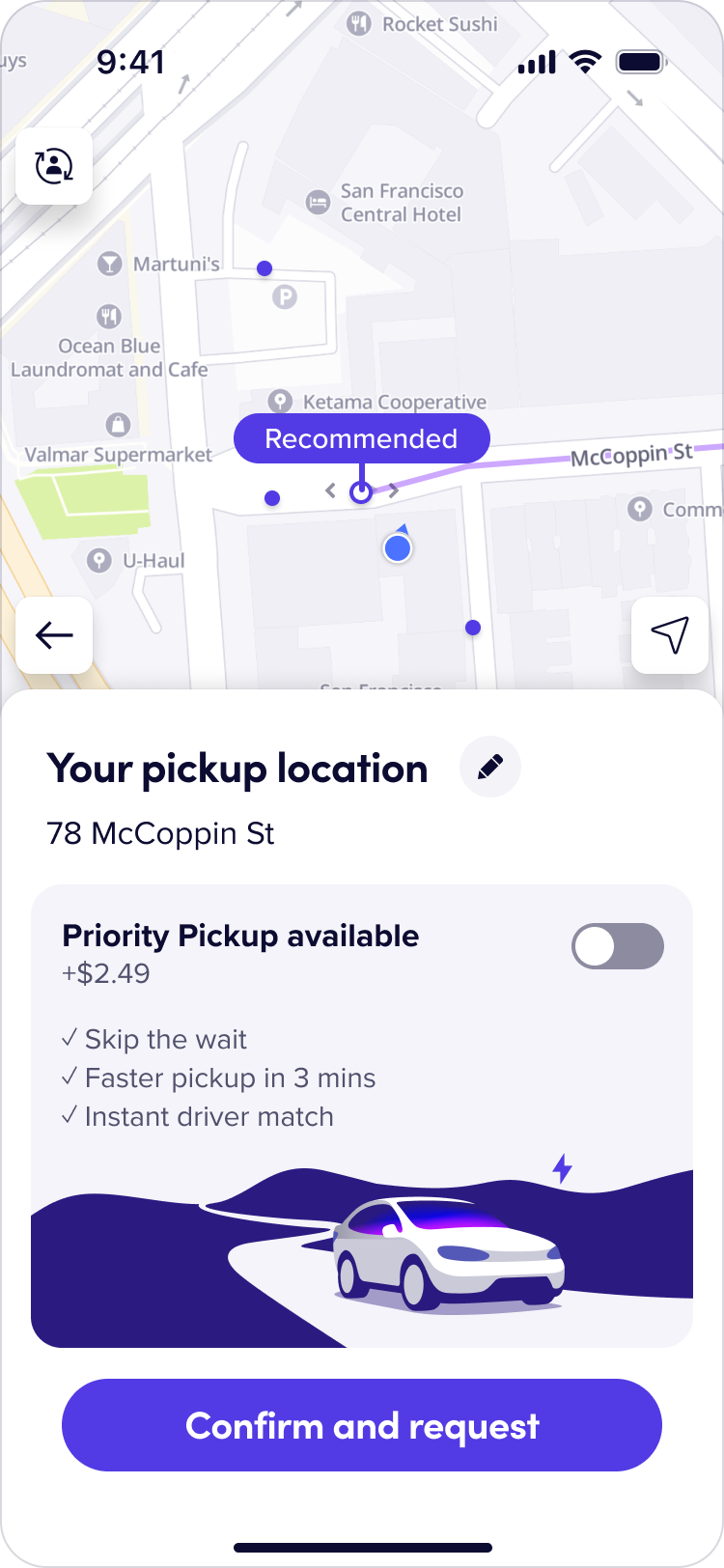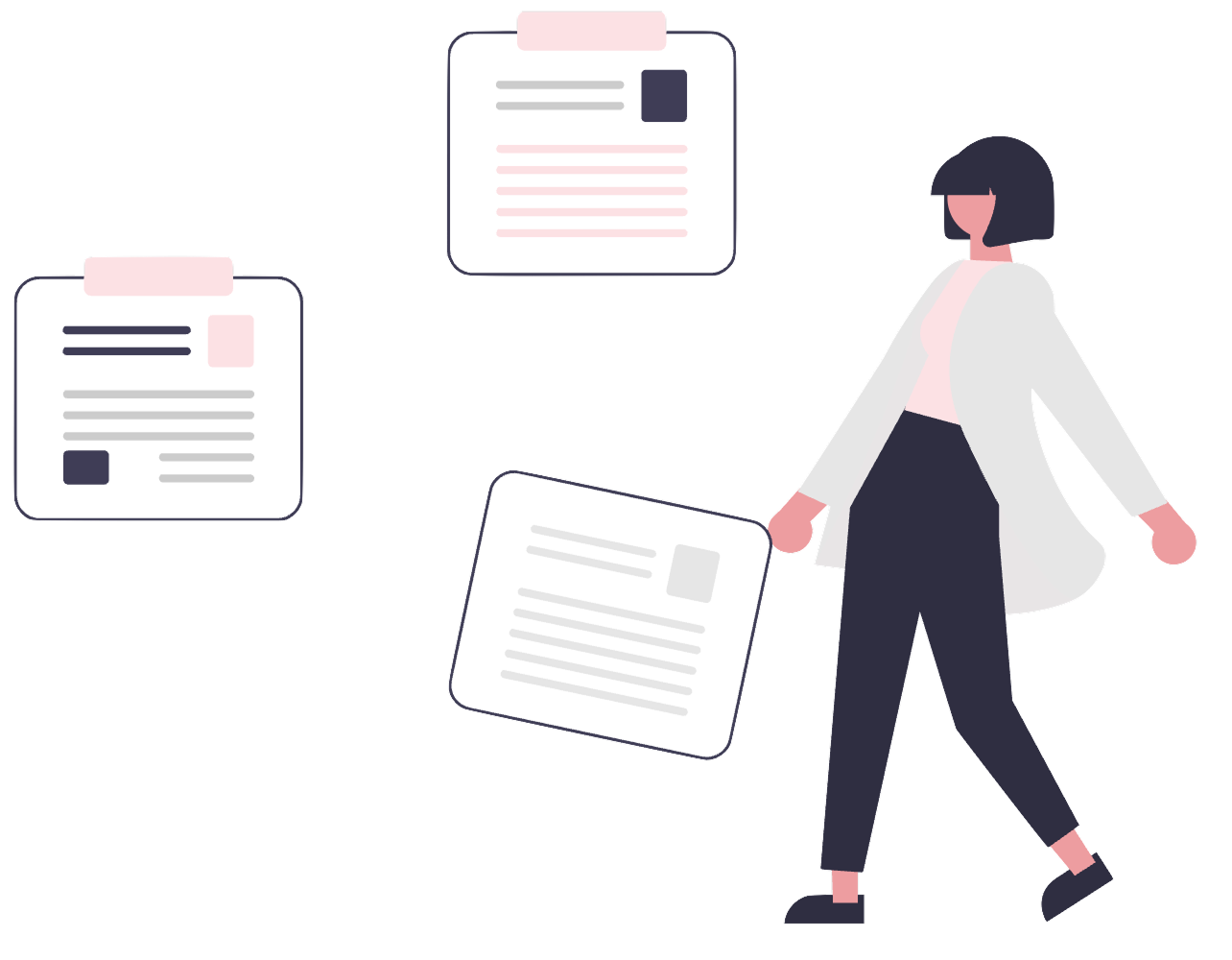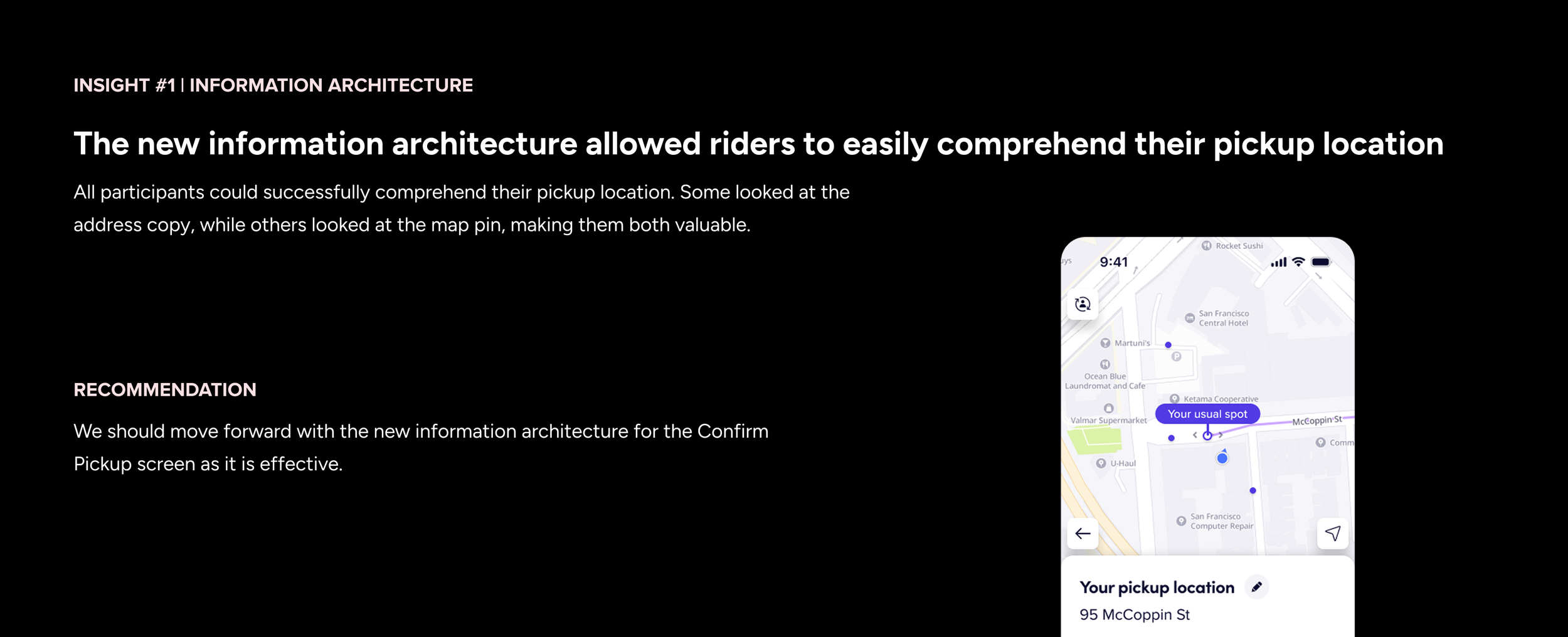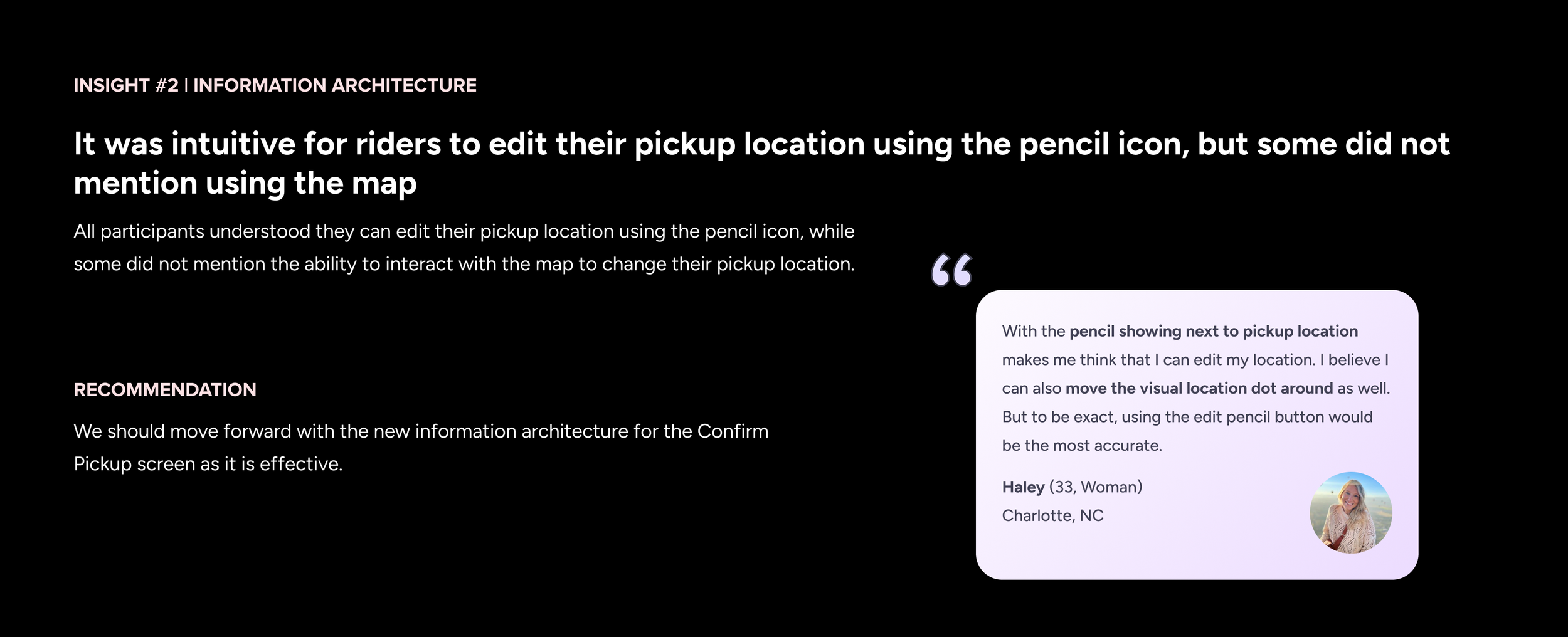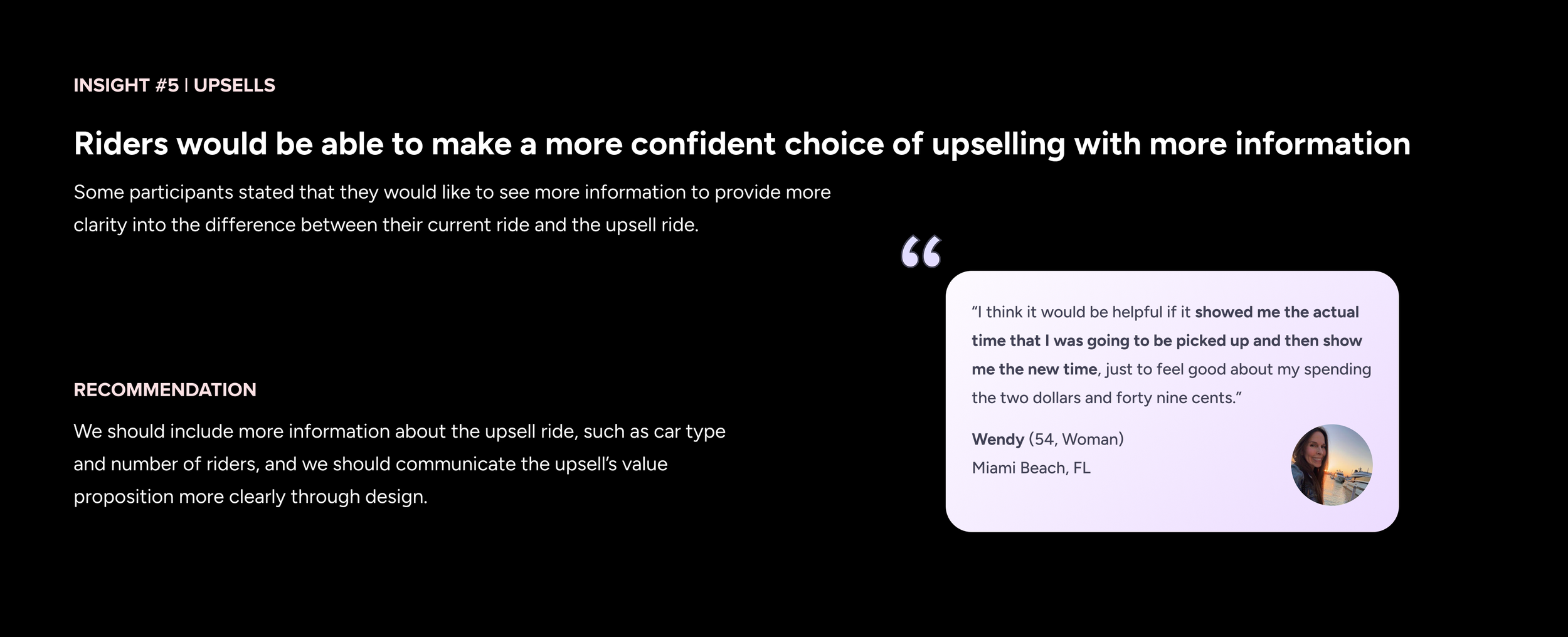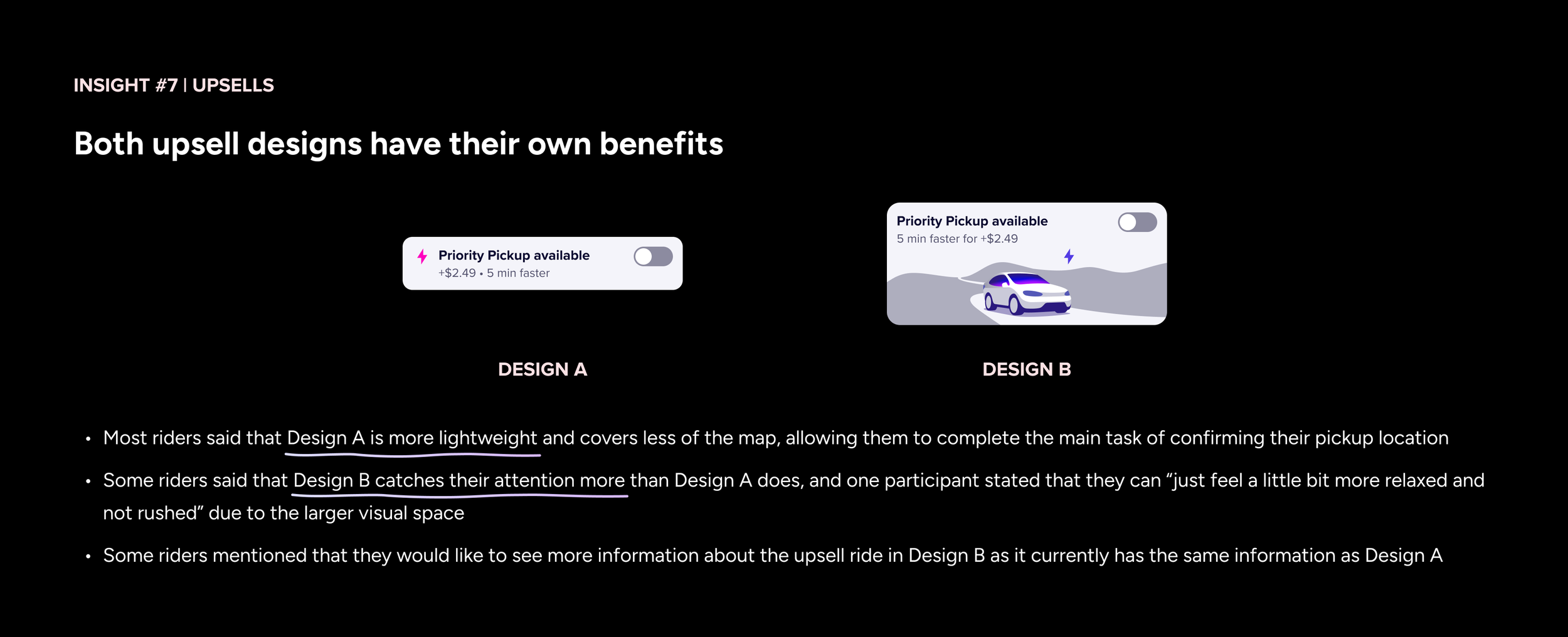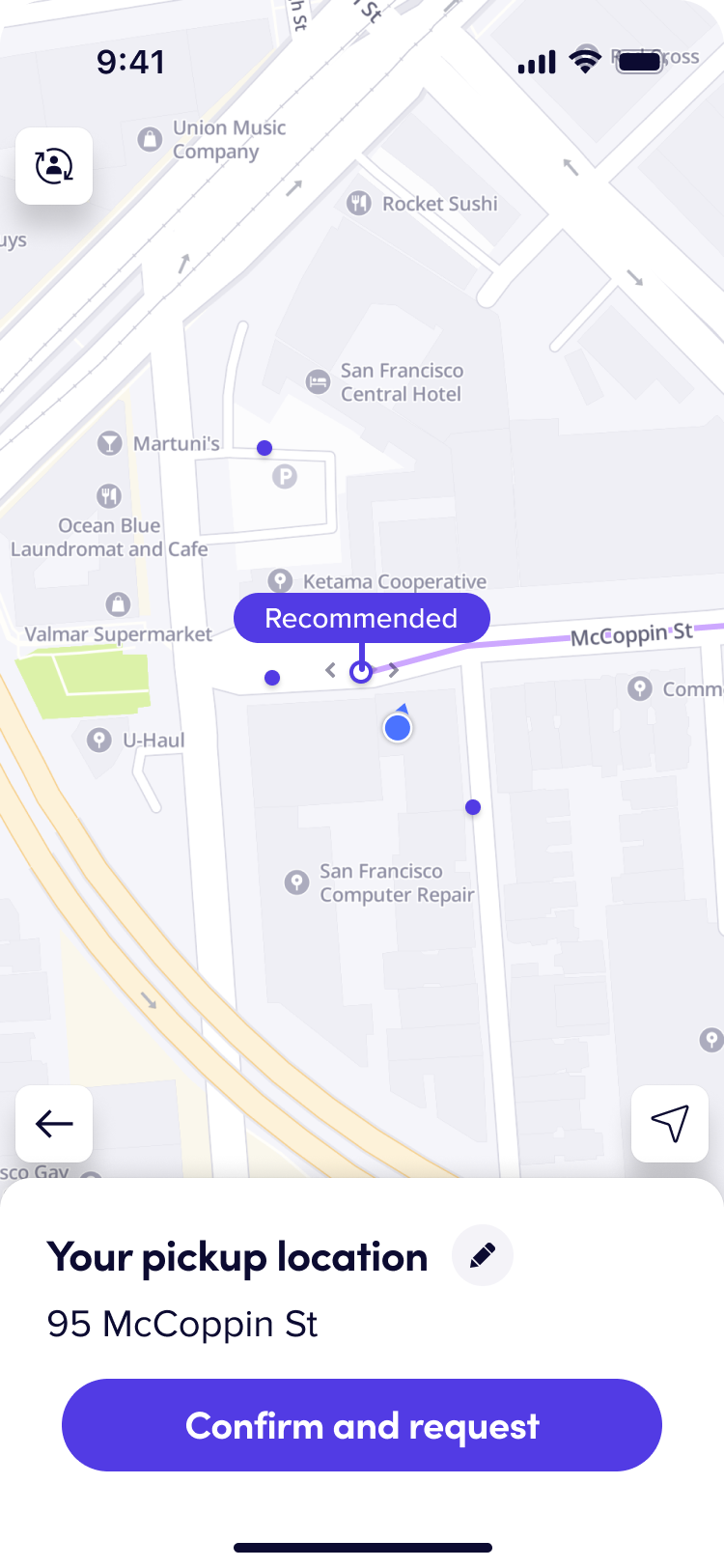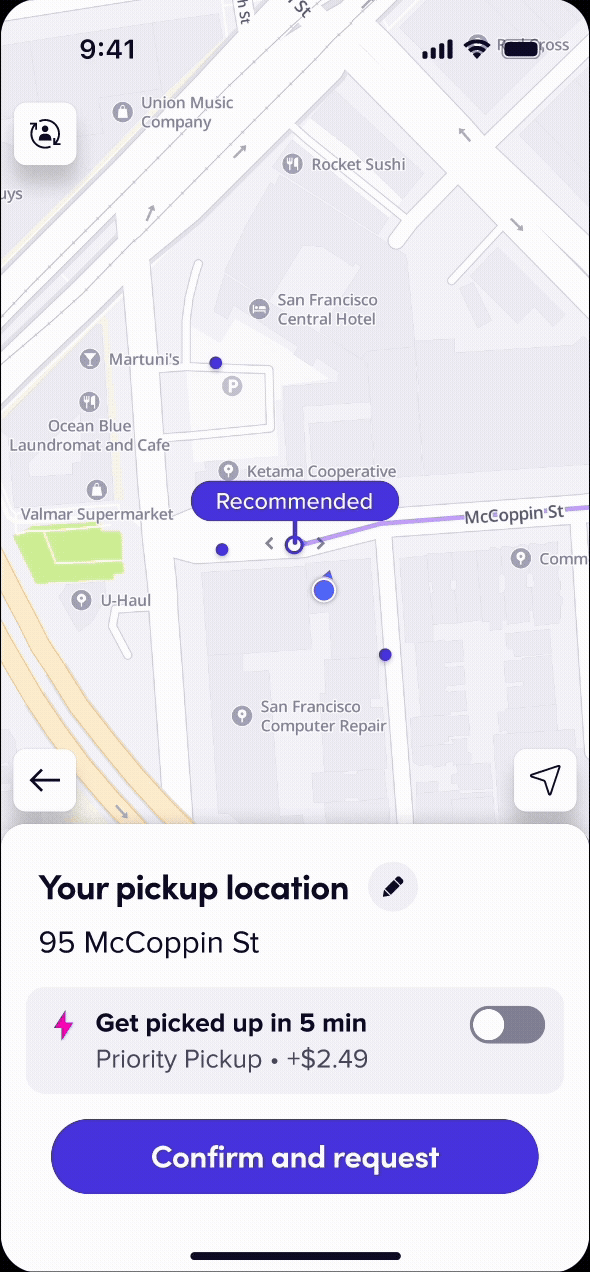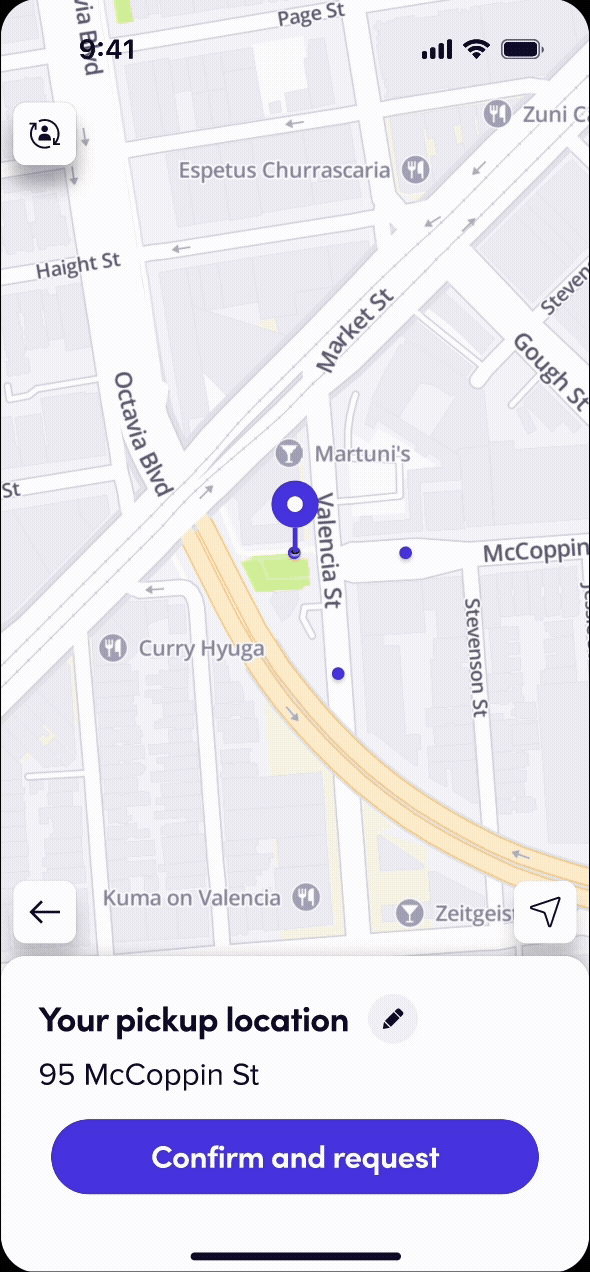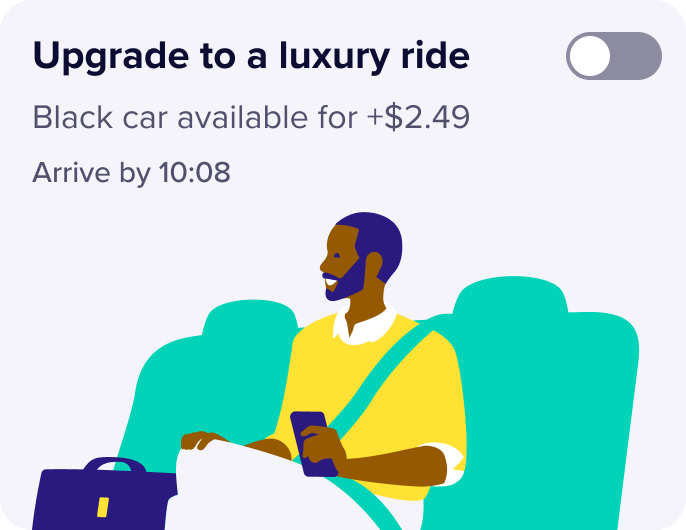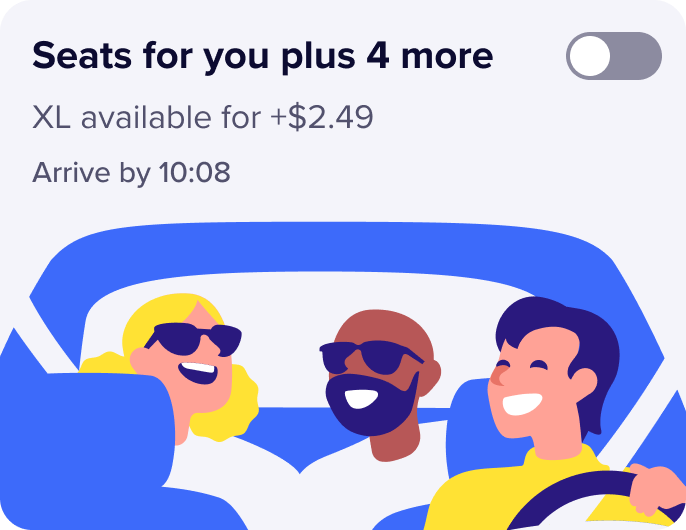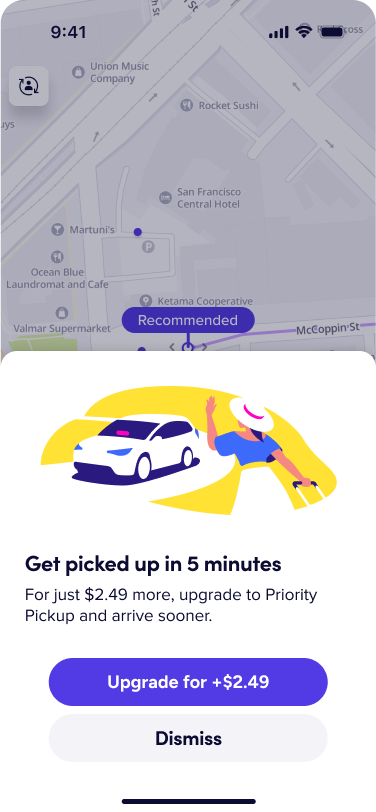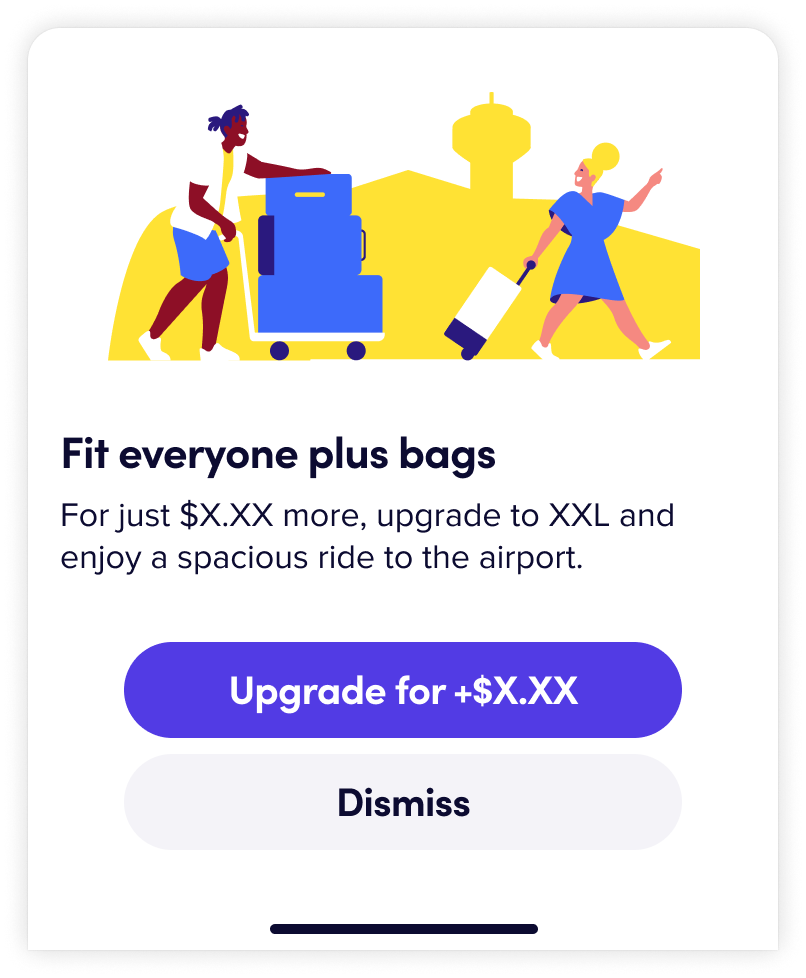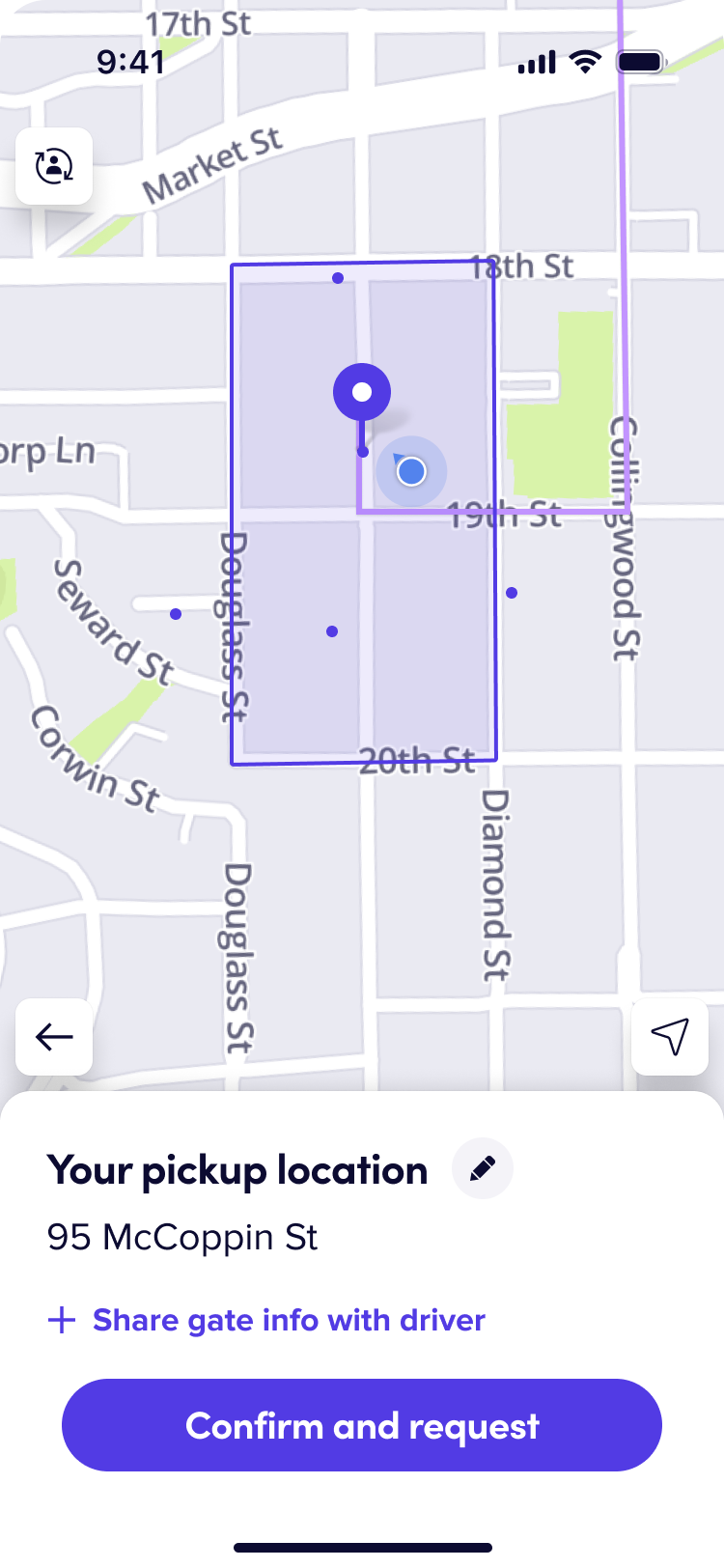ROLE
Product Design Intern
TIMELINE
Jun 2025 - Sep 2025
TEAM
Core Rider Experience
Redesigning the app’s Confirm Pickup screen to reduce friction, enhance rider confidence, and integrate ML-driven upsells
SKILLS
User Research
Product Design
Product Strategy
AI Integration
TOOLS
Figma
Dscout
Gemini AI
PROJECT OVERVIEW
Confirm Pickup is the critical final step in Lyft’s pre-request flow where riders verify their pickup location before booking the ride. This moment ensures riders are seamlessly picked up at the correct spot. User intent to book a ride in this screen is very strong at ~98%, presenting the opportunity to increase Lyft’s profit margins at this point of the Golden Path.
THE PROBLEM
Over the years of Lyft’s evolution, different features like Change rider, Driver notes, Venue selector, and upsells have begun to crowd the overall architecture of Confirm Pickup. This leads to cognitive overload for riders, and thus presents an opportunity to re-evaluate how this step supports accuracy, clarity, and adaptability.
Checkbox may not be the best UI
Copy has too many numbers
No visual callouts that entice users
At the same time, upsell opportunities are inconsistently surfaced and often lack relevance. The current upsell in Confirm Pickup lacks visual appeal, and users aren’t seeing the value in them.
Upsell’s value is not well-communicated
Text-heavy panel
Distracting location text prompt field
1.6M
Upsell attempts
Redesigning the Confirm Pickup screen and its upsell flow was a key initiative in Lyft’s product roadmap, given its high visibility and potential to not only enhance the rider journey but also drive revenue through higher conversion rates on high-margin bookings. I owned the end-to-end design process, partnering closely with Product, UXR, Engineering, Content, and Data Science to deliver a much-needed upgrade to this critical in-app
Given the context, this project was built around the problem statement:
How might we improve the Confirm Pickup screen’s Information Architecture and Upsells?
My designs have been approved by stakeholders for experimentation and are on track for an H1 2026 launch.
Features are fighting for attention
Crowded information architecture
6.5K
Completed upsells
0.4%
Conversion rate
This data point shows the extremely low success rate and weak performance of upsells on Confirm Pickup today, highlighting the opportunity to re-imagine this feature.
DEFINING THE SCOPE
To deepen my understanding of this complex scope and identify key constraints, I leveraged insights from existing research, conducted a competitive audit, and analyzed Lyft’s current recommendation system that powers upsells along the app's Golden Path.
Hypothesis
If all of this is achieved successfully, there will be an increase in the conversion rate of Confirm Pickup Upsells:
The Confirm Pickup screen needs to have less feature density, allowing more room for upsells
Visual design and delight should be leveraged to bring attention to upsells
The value of upsells must be clearly communicated and reinforced to users
Existing Research
PRE-REQUEST CONCEPT TESTING (OCT-NOV, 2022)
Riders with varied mode mixes responded positively to upsells on the Confirm Pickup screen as they could quickly weigh the costs vs. benefits to see if the upsell is a good fit for them. The upsell should be concise and scannable, allowing riders to know what they're getting and what it costs after a 1-3 second glance.
NEW RIDER UX (NOV, 2024)
Riders, especially new ones, need extra guidance in complex locations like airports, universities, and hotels. The Confirm Pickup screen’s main task is to help riders confirm their pickup spot; it should have Clear UI and education features to help them navigate and understand Lyft’s full range of offerings.
Competitive Audit
By looking at other consumer apps that successfully surface upsells, I identified common strategies and experiences that can be implemented into Lyft’s pre-request flow.
Key Insights
Contextual & Integrated Upsells
Successful upsells are not separate pop-ups or distractions. They are seamlessly woven into the primary user flow, appearing at the most relevant moment in the user's journey.
Clear Value Proposition
Each upsell clearly and transparently answers the question, "Why should I pay more?" The value is communicated concisely upfront, often with specific, tangible benefits.
Efficient Information Hierarchy
All apps manage complex information without overwhelming the user. They prioritize essential information and use design to guide the user's focus, allowing them to complete their task.
Upsells Recommendation Model
Upsells across the Golden Path are driven by a machine learning recommendation system that determines when and where to surface them in a rider session. The model factors in contextual cues to ensure that each upsell feels relevant, ultimately increasing rider confidence in upgrade decisions while supporting business goals around conversion.
Confirm Pickup
Post-request
The recommendation model’s goal is to integrate LTV guardrails by minimizing Negative Experiences. To make this possible, the feature has rate-limiting rules that distinguish conditions for Confirm Pickup vs. Interstitial Upsells:
If a session is only eligible for one type of upsell (either Confirm Pickup or Interstitial), that upsell is passed on
Interstitial upsells are rate-limited to one per user every 3 days if the upsell is declined
If a session is eligible for both CP and Interstitial, the model should determine which upsell to surface based on conversion confidence
After gaining a deeper understanding of the upsell ecosystem, I realized my solution needed to not only address the initial HMW problem statement, but also align with the ML-driven recommendation model. This pushed me to iterate on the framing, evolving the challenge into:
Pre-request
Interstitial
Post-match
How might we improve the Confirm Pickup screen’s Information Architecture and Upsells?
+ build a smart and consistent upsell experience throughout the pre-request flow?
IDEATION & ITERATION
With this context and information in mind, I explored divergent concepts and iterated with feedback from design jam and critique sessions with my team and XFN partners. To get my pre-request juices flowing, I started off with some wireframe sketches:
Information Architecture
The first part of my project is to redesign the layout and UI of the Confirm Pickup screen. It has grown cluttered over time, making it difficult for users to focus on what really matters. Building off my initial wireframes, I explored four different directions, diverging early to see what worked best before narrowing down and refining one strong concept.
Floating UI
Iterated IA Design
New edit button (LPL)
Address copy
Banner contents
Inverse hierarchy
Flexible
Accessible
Waymo-inspired
Although each concept explored different IA possibilities, I decided to focus on simplifying the panel itself, reducing visual clutter and cognitive load while staying mindful of resource constraints. Limiting changes within the panel made it more feasible to implement by minimizing engineering effort and cost compared to a full-page overhaul. With that, I landed on this iteration:
Pickup location in heading
Map education copy
After presenting these designs at design critique sessions and conducting quick pressure tests, I learned that:
Not accessible with dynamic text
Components are not LPL (Lyft’s design system)
Not compatible with long addresses
Edit location button
Subtle in-line upsell
Too much text diluted in the panel
Unclear information hierarchy
Not enough visual callout for upsells
I applied these learnings to further iterate on the panel design, honing in on the content and features that mattered most, which led to this version I brought into user testing:
Clean and simple
Removed unnecessary text and elements, making the panel de-cluttered.
The panel component works seamlessly with other features such as pickup notes.
The copy is compatible with long addresses and dynamic text, and works with different languages.
Familiar layout
The experience is intuitive with no learning curve, matching riders’ mental model.
Upsell Explorations
Looking at ways we can bring visual delight and draw riders’ attention to the upsells while clearly communicating their value.
Iterated Upsell Design
Through conversations with stakeholders, I landed on a version that acts as a lightweight add-on to the panel, keeping it scalable for future upsells while maintaining harmony with existing information like the address copy.
Designs for each upsell:
Micro-animation
Filled background for visual distinction
Worked mainly with the panel as it builds a more cohesive and consistent Confirm Pickup experience
Toggle UI
A UXR Report on upsells from April 2025 shows that most riders preferred a Toggle UI because it was more noticeable, clear whether it was on/off, and satisfying.
Mode-led
The UXR Report also found that mode-led content was more visible and provided increased clarity as to what a rider would be paying for.
Expanded Upsell Explorations
Because riders interact with the Confirm Pickup screen in different contexts, I introduced an expanded upsell that appears in high-confidence locations, like home or work. This approach increases visibility and conversion potential without adding friction, as it only surfaces in situations where users don't need to edit their pickup or interact with the map.
Iterated Expanded Upsell
Consistent with basic upsell
After discussing with my team, I realized that while these versions increased upsell visibility, they also introduced too much friction and distracted users from the main task of confirming their pickup. I iterated toward a version that remains visually engaging but preserves the screen’s usability.
Follows the same Toggle UI pattern to keep the interaction lightweight and mode-led content to communicate the upsell’s value prop.
Visually prominent
Uses more space, combining illustrations from Offer Selector and a vector background to create a “bleeding” graphic in the display card.
Map pin copy
The map pin copy changes to “Your usual spot” to subtly inform the rider that they are getting picked up from a high-confidence location.
Product Principles
Lead with Clear Value
Every upsell must offer a tangible, relevant benefit (like time savings, extra comfort, or space) that's immediately obvious and solves a user's current or anticipated need.
Be Contextually Smart
Deliver upsells precisely when and where they make sense for the rider, based on factors like ETA, price, destination, wait times, or past behavior. Make them feel like an opportunity uncovered, not an interruption.
Empower & Affirm Choice
Present options transparently, allowing riders to easily accept or decline without pressure. Once an upsell is accepted, positively reinforce their decision to make them feel savvy and confident.
Balance Consistency with Context
Upsells should look and feel familiar so users recognize the opportunity, but the design should still flex to fit the moment, adapting smartly to context and user needs.
USER FEEDBACK
With these designs and principles in mind, I worked closely with the UXR team to write, program, and launch an unmoderated usability test on Dscout with 10 participants to evaluate the new Confirm Pickup IA and upsell designs.
Learning Objectives
PICKUP LOCATION
How easy or not is it for riders to comprehend their pickup location?
How easy or not is it for riders to change their pickup location?
PICKUP NOTES
How easy or not is it for riders to understand that they can leave a pickup note?
UPSELLS
Are riders getting the information they need to make the choice of upselling?
Are riders able to successfully select and confirm the upsell?
Do the upsells have enough visibility and discoverability?
Summary
The new Confirm Pickup design is effective, with opportunities to clarify pickup notes, educate map use, and enhance upsells with more detail and contextual relevance.
THE SOLUTION
✦ STREAMLINED INFORMATION ARCHITECTURE
Simplifying the Confirm Pickup screen's information architecture and streamlining its flows not only reduces users' cognitive load and improves usability, but also creates more space for upsells by lowering feature density.
✦ IMPROVED UPSELLS
By using thoughtful and delightful visual design to highlight upsells, clearly communicating their value to users, and aligning the feature with the ML-driven recommendation system, this approach boosts conversion rates and increases overall profit margins.
Final Designs
✦ INFORMATION ARCHITECTURE
✦ MAP EDUCATION ANIMATION
✦ CONFIRM PICKUP UPSELL
This redesign established a cleaner and more flexible foundation, allowing the panel component to feel more natural and contextually aligned with the rider’s journey.
Pickup instructions
If users are in situations where pickup notes surface
To ensure that riders are still aware they can edit their pickup location via the map, I added a micro-animation of the map pin “hopping” that gets triggered whenever a rider gets brought to the Confirm Pickup screen.
Removing the current “Drag map or edit address to set your pickup” poses little risk as users already expect maps to be interactive, a mental model reinforced by other map interfaces on Google Maps, Uber, etc.
Upsell designs:
Gate information
If users are in gated communities detected by mapping
Instead of using mode-led content, we’ve decided to lead with the upsells’ value prop. At this stage of the Golden Path, riders have just come from Offer Selector, so there is no need to state the mode types again.
We should leverage what riders are getting and the most important details: amenity, price, and capacity.
Venues
If users are in venues with directions to pickup location
✦ EXPANDED UPSELL
Following the same logic for value-led upsells, I iterated on the expanded upsell designs:
Introducing a new upsell variant with its own conditions and rules would require a major overhaul of the existing recommendation model. The technical costs and engineering effort are significant for a feature that hasn’t been proven to be successful yet. Additionally, the design would require building and maintaining a new component in Lyft's design system, adding long-term maintenance responsibilities for both engineering and design.
I pivoted the upsell strategy by bringing the strongest elements of these designs into the existing interstitial upsells - already supported by the ML-driven recommendation model - and refining their visual and content design to make them more relevant and compelling for riders.
✦ INTERSTITIAL UPSELL
Current design
Designs for each ride mode:
✦ PARTNER REWARDS
New design
While slightly outside my project scope, interstitial upsells are due for a visual refresh. Interstitial upsells currently have a success rate of ~4%, and making them more relevant to riders could significantly boost performance and overall upsell PMM.
The recommendation model should surface an interstitial upsell over a CP upsell if conversion confidence is high because it has guaranteed visibility.
A key part of the Rider org’s 2025-2026 Upsell Strategy is to make upsells more relevant and compelling by incorporating discounts and partner rewards.
This flexible component allows us to integrate multiple business initiatives into upsells, drawing more attention to the feature and eventually increase PMM conversion.
Pickup Notes
As a key part of the Confirm Pickup experience, part of my final solution also explored how pickup notes could better integrate with the new panel architecture. As found in user feedback, the current notes feature is too open-ended, which can confuse riders, as the difference between this feature and texting a driver is not distinct enough. By tailoring notes to a rider’s context, this feature can become more intuitive and useful.
✦ GATE INFORMATION
Updated entrypoint copy
Updated entrypoint copy
User history persists
When Lyft’s mapping system detects a rider getting picked up from a gated community, an entry point to share a gate code will surface on the panel. With this streamlined workflow, only two clicks are required to perform this task.
✦ PICKUP INSTRUCTIONS
Toast
Consistent design
For general use cases of ordering a ride from pickup locations where instructions are needed, the workflow to add them is improved with an updated heading, a new subheading for clarification, and more user-friendly visual designs.
Product Framework Rules
As the upsell ecosystem grows more complex, I defined a product framework that establishes clear rules for when and how upsells should appear, ensuring consistency and scalability across different touchpoints. This helped align design, product, and engineering decisions around a shared logic for smarter, more context-aware upsells.
Avoid upselling if a rider is trying a new mode
For example, if a rider is taking extra comfort for the first time based off our product marketing efforts to drive that mode adoption, we shouldn’t be upselling them to a different mode, second-guessing their choice.
Make upsells more intelligent
Make upsells more aware of each other across the Golden Path and of rider intent signals (e.g. time spent on OS, modes tapped), allowing targeting and triggering decisions by the recommendation model to reflect the full context from pre-selection to post-request.
Make upsells aware of Offer Selector context
If riders select an add-on in Flexible Offer Surface, no upsells should be surfaced as this would be over-serving and disturbing the rider experience.
Predictive Completion Model
As a guardrail for upsell trigger rates, the recommendation model should take whether a Rider selected an upsell the last time they saw it into account.
Measures of Success
If the new Confirm Pickup and upsell designs meet these metrics, it solves both the business and user problem and will be on track for an H1 2026 launch:
Higher Upsell Conversion
Increasing conversion at both Confirm Pickup and Interstitial points shows riders find upsells more relevant and valuable. This directly drives revenue and aligns with rider decision-making.
Better Confirm Pickup Usability
Reducing pickup errors and cancellations builds rider confidence and trust. A smoother experience also decreases rider dissatisfaction and churn tied to pickup frustrations.
Increased Profit Margins and Bookings
More upsell adoption leads to more high-margin mode bookings and greater profit margins per rider session. This reflects stronger business performance and long-term growth.
Greater Traction in Other Features
Surfacing related features like Lyft Cash Back or Driver Notes increases adoption beyond upsells. This creates additional value and engagement across the Lyft ecosystem.
REFLECTIONS
Beyond learning how to design for a consumer-facing product built on advanced technical systems, here are some of my personal takeaways from this project:
XFN Collaboration
Learned to work with XFN partners and align priorities across PM, Data, Eng, Research, Content, and Legal, balancing diverse needs while keeping design and user experience at the center.
Confidence in Craft
Built conviction in trusting my gut when faced with different perspectives by using research and metrics to back decisions, while staying open to feedback to strengthen designs.
Staying Objective
Learned to avoid personal bias by grounding decisions in testing, data, and research, ensuring solutions meet the needs of Lyft’s diverse rider base rather than my own preferences.
This project reminded me that great design isn’t just about beautiful interfaces: it’s about aligning vision, feasibility, and empathy. Working on a product as complex and high-impact as Lyft taught me how to navigate ambiguity, make informed trade-offs, and advocate for users while still driving business goals forward. My internship at Lyft pushed me to grow in ways I didn’t expect, teaching me to trust my instincts while staying open to critique, and collaborating effectively across disciplines. More than anything, it reinforced why I love product design and the challenge of solving real problems through thoughtful craft.

